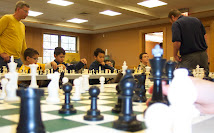I posted below two games annotated by my team mates Eric Marc and Al Walters from the recent World Amateur team. Eric drew national master Jim West in a very exciting thematic Sicilian sacrifice on b5 and Al Walters started the tournament with a first round upset of Expert Frederick Kurrasch.
2011.02.21"]
[Round "5"]
Eric Mark (1969) - Jim West (2215)
US Amateur East 2011
[Annotator "Mark,Eric"]
Jim West and I played once before at the USATE, the year his team won the event. That game was a long hard draw; I thought he might remember my name or face, but it seemed not so, as I staggered into the Hilton ballroom a few minutes after 9 a.m. on a snowy bleak morning, for round five.
1. e4 c5 2. Nf3 d6 3. d4 cxd4 4. Nxd4 Nf6 5. Nc3 a6 6.Bg5 e6 7. f4 Be7 8. Qf3 Qc7
9. O-O-O Nbd7 10. Bd3 b5 11. Rhe1 Bb7 12. Qg3 O-O-O
Spassky played 13. Bxf6 against Fischer in game 15 of the 1972 match. The game was drawn, after White (and later possibly Black) missed chances.
Two years later, wild-eyed GM Velimirovic unveiled a new idea 13. Bxb5. The first time I played 13. Bxb5, in 1989, was against Tom Ostrosky in Hackettstown---long before many players in this year's USATE were born.
13. Bxb5 axb5 14. Ndxb5 Qb6 15. e5 Nc5
Jim's 15...Nc5 is likely the best move; Here I recalled a trick from Jim's analysis that I glanced at years ago: White must beware Qf2, lest he drop the Queen to Nb3+.
(15...dxe5 16. fxe5...Nd5?! (Nh5 is better) 17. Bxe7 Nxe7 18. Nd6+ followed by Nxf7 and White is close to winning.)
16. exf6 (16. Qh4!?) gxf6 17. Bh4 Rhg8 18. Qe3 Rxg2 19. Bg3 f5 20. Nd4 Bf6 21. Nf3 Be4! 22. Nd2?
22. ...Bd4?
(22 ... d5! wins a piece. The threat is simply ...d4, forking and winning a piece. White cannot stop it without allowing something worse; his pieces are tied to varied defensive duties. But WHY JIm overlooked that might be interesting. Remember the idea from his old analysis about winning a White Qf2 with discovered check? Perhaps that theme rolling around in his memory helped him find the scary-looking but unclear 22...Bd4?! . Black "wins" White's queen for three minor pieces and some pressure. (23. Qxd4...Nd3+; discovered attack.) Objectively it's unclear but a bit better for Black;
23. Qxd4 Nd3+ 24. cxd3 Qxd4 25. dxe4 Qd3 26. Rg1 Rxg1 27. Rxg1 fxe4 28. Ncxe4 Rd7
29. Rf1 Rc7+ 30. Nc3 f5 31. Rf3 Qa6 32. Kb1 d5 33. Nb3 Qc4 34. Nd2 Qd4 35. Nb3 Qg1+
36. Kc2 Rg7
(36 ... d4 37. Bf2 Qg2 38. Nd4 Rc4! seems winning for Black. Black wins a piece, since all White's pieces are pinned or tied to defending one another. Same theme as Black's missed chance on move 22....Queen should win against Bishop, Knight and (maybe) pawn, of course. White can play on, but it's likely hopeless.)
37. Ne2 Qg2 38. Re3 Rc7+ 39. Kd2 Kd7 40. Nbd4 1/2-1/2
Walters, Al (1739) - Kurrach (2080)
US Amateur East 2011
1.e4 c5 2.Nf3 d6 3.Bb5+ Nc6 4.d4 cxd4 5.Nxd4 Bd7 6.0–0 Nf6 7.Nc3 g6 8.Be3 Bg7 9.Nxc6 bxc6 10.Be2 0–0 11.Rb1 c5?! 12.Qd2 Rb8 13.Bh6 Qa5 14.Bxg7 Kxg7 15.Rfd1 Bc6 16.Bf3 Nd7 17.a3 Rb7 18.Nd5?
I lose the thread on move 18 and stumble for the next 4 moves or so. Turns out I hit the wrong attack plan, as I was determined to loosen his e & d pawns. This gave black counterplay. He starts out correctly, but quickly stumbles as well, with incorrect follow up. A real curiosity, as black never brings his K rook into play on the Queen side ( even after preparing it with a QR lift?!) even his artificial move on 24 called for an obvious Re8 (as he pointed out post game), but used his King to defend instead.
Nxa4 27.c3 Rxc4 28.bxc4 Nb2 29.Rf3+ Kg7 30.Rxe7 a4 31.Ra7 g5 32.g4 Kg6 33.Re3 Nxc4 34.Re4 Nb2 35.Re2 Rb8 36.Ree7 Rf8 37.Reb7 Nd1 38.c4 Nc3 39.Rd7 Re8 40.Rxd6+ f6? 41.Rdd7 Rg8 42.Re7 h5 43.h3 1-0





No comments:
Post a Comment